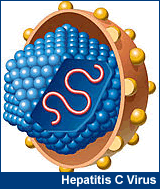BI201335
Shows Potent Activity against HCV
SUMMARY
HCV protease inhibitor BI201335 plus pegylated interferon/ribavirin
was well-tolerated and demonstrated good activity in treatment-naive
and -experienced genotype 1 chronic hepatitis C patients. |
By
Liz Highleyman
 The
advent of direct-acting antiviral agents active against different
steps of the hepatitis C virus (HCV) lifecycle will dramatically
change therapy, especially for difficult-to-treat patients. Current
drugs, however, still must be used in combination with pegylated
interferon alfa (Pegasys or PegIntron) plus ribavirin.
The
advent of direct-acting antiviral agents active against different
steps of the hepatitis C virus (HCV) lifecycle will dramatically
change therapy, especially for difficult-to-treat patients. Current
drugs, however, still must be used in combination with pegylated
interferon alfa (Pegasys or PegIntron) plus ribavirin.
The
first 2 HCV protease inhibitors -- boceprevir
(Victrelis) and telaprevir
(Incivek) -- were approved in May; next-generation agents
are currently moving through the development pipeline.
As described in the June
2011 Journal of Hepatology, Michael Manns from Hannover
Medical School and colleagues evaluated the safety and efficacy
of Boehringer-Ingelheim's candidate, BI201335,
in a dose-escalation trial of treatment-naive and experienced
participants.
A total of 34 previously untreated genotype 1 chronic hepatitis
C patients were randomly assigned to receive BI201335 at doses
of 20 mg to 240 mg once-daily, or else placebo, for 14 days, followed
by pegylated interferon/ribavirin through day 28. In addition,
19 treatment-experienced people received 48 mg to 240 mg BI201335
once-daily in combination with pegylated interferon/ribavirin
for 28 days.
Results
 |
Treatment-naive
patients experienced good viral load reductions at all doses: |
 |
3.0
log median maximal reduction in 20 mg group; |
 |
3.6
log reduction in 48 mg group; |
 |
3.7
log reduction in 120 mg group; |
 |
4.2
log reduction in 240 mg group. |
|
 |
Most
people receiving monotherapy experienced HCV viral load breakthrough
(at least 1 log increase from the nadir or lowest level). |
 |
Viral
breakthrough was associated with NS3/4A mutations including
R155K and D168V that conferred resistance to BI201335 in vitro.
|
 |
Adding
pegylated interferon/ribavirin during days 15-28 led to continuous
HCV viral load reductions in most patients. |
 |
Among treatment-experienced participants, treatment with BI201335
plus pegyalted interferon/ribavirin produced undetectable
viral load (< 25 IU/mL) at day 28 in a majority of patients: |
 |
50%
(3 of 6) in the 48 mg group; |
 |
57%
(4 of 7) in the 120 mg group; |
 |
83%
(5 of 6) in the 240 mg groups. |
|
 |
16%
of previously treated patients experienced viral breakthrough
during triple combination therapy. |
 |
Prior
relapsers achieved 28-day rapid virological response (RVR)
rates similar to those of treatment-naive individuals. |
 |
Previous
partial responders and null responders had similar response
and breakthrough rates across all dose groups. |
 |
BI201335
was generally well-tolerated in both treatment-naive and treatment-experienced
patients. |
 |
The
majority of adverse events were mild-to-moderate, not dose-dependent,
and judged to be unrelated to BI201335. |
 |
4
patients experienced mild skin rash or photosensitivity. |
 |
Mild
elevation of unconjugated bilirubin was the only dose-dependent
laboratory abnormality. |
 |
No
hemolysis (blood cell destruction leading to anemia) or liver-related
"events of concern" were reported. |
 |
Pharmacokinetic
analysis showed that BI201335 had an elimination half-life
supporting once-daily dosing. |
"BI201335
combined with [pegylated interferon/ribavirin] was well-tolerated
and induced strong antiviral responses," the study authors
concluded. "These results support further development of
BI201335 in HCV genotype 1 patients."
BI201335 "induced a rapid, dose-dependent decrease in plasma
HCV RNA" by more than 2 log in all patients," they elaborated
in their discussion. "Maximal viral load declines from baseline
occurred within 2-3 days of first administration."
"The
magnitude of viral load declines was similar to those recorded
for other highly potent protease inhibitors in development,"
they added, but this was achieved with once-daily dosing compared
with 3 times daily for boceprevir and telaprevir.
The
high rate of rapid viral breakthrough during the monotherapy phase,
however, underlines the importance of combination therapy with
either pegylated interferon/ribavirin or all-oral regimens with
other direct-acting agents that inhibit HCV polymerase or other
viral targets.
The
researchers noted that these variants have also been seen with
other HCV protease inhibitors including boceprevir, telaprevir,
RG7227 (a.k.a. ITMN-191), and TMC-435, and therefore are "likely
to confer cross-resistance and to eventually cause virologic breakthrough
in case of combination or sequential treatment with different
compounds of this class."
Researchers
reported
data from later, larger trials of BI201335 plus pegylated interferon/ribavirin
in treatment-naive and treatment-experienced participants (SILEN-C1
and SILENC-2) at the European Association for the Study of the
Liver's International Liver Congress (EASL 2011) this spring in
Berlin.
Investigator
affiliations: Hannover Medical School, Department of Gastroenterology,
Hepatology, and Endocrinology, Center for Internal Medicine, Hannover,
Germany; Hopital Saint Joseph, Marseille, France; Hopital Pitie
Salpetriere, Paris, France; Hopital Cochin, Paris, France; California
Pacific Medical Center Research Institute, San Francisco, CA;
Hopital Hotel Dieu, Lyon, France; Central Texas Clinical Research,
Austin, TX; Charité Berlin Campus Virchow-Klinikum, Berlin,
Germany; Hospital Universitano Puerta de Hierro, Madrid, Spain;
Boehringer Ingelheim (Canada) Ltd., Laval, Canada; Boehringer
Ingelheim Pharmaceuticals, Inc., Ridgefield, CT; Boehringer Ingelheim
Pharma GmbH & Co. KG, Biberach, Germany.
6/7/11
Reference
MP
Manns, M Bourliere, Y Benhamou, et al. Potency, safety, and pharmacokinetics
of the NS3/4A protease inhibitor BI201335 in patients with chronic
HCV genotype-1 infection. Journal of Hepatology 54(6):1114-1122
(abstract).
